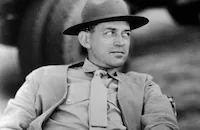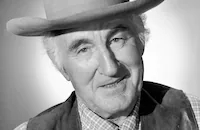The Pagan

Brief Synopsis
Cast & Crew
W. S. Van Dyke
Ramón Novarro
Renée Adorée
Donald Crisp
Dorothy Janis
Nacio Herb Brown
Film Details
Technical Specs

Synopsis
Henry Shoesmith, Jr., a handsome islander, devotes his days to singing and his nights to romance. He falls in love with Tito, a native girl who has been adopted by Slater, a trader, and when Slater and Tito leave the island, Henry gives up his idle ways and turns to storekeeping. Tito and Slater later return to the island, and the rough trader attempts to force her to marry him. Henry learns of this and abducts the willing girl, taking her to his mountain home. Slater later takes her back; Henry again rescues her. All ends well.

Director

W. S. Van Dyke
Cast
Ramón Novarro

Renée Adorée

Donald Crisp

Dorothy Janis
Crew

Film Details
Technical Specs

Articles
The Pagan
The story is set "in the farthest reaches of the Pacific," on islands, "spawn in ancient volcanoes...remote and peaceful and garlanded with flowers." On one such corner of paradise lives Henry Shoesmith, Jr. (Novarro), a "half-caste" who has inherited a coconut plantation but is less interested in running a business than absorbing the beauties of nature. Henry's island is visited by ruthless coconut oil trader Roger Slater (Donald Crisp), who is the self-appointed guardian of Tito (Dorothy Janis), a young Polynesian woman whom he feels it is his "Christian duty" to civilize -- civilization in this case meaning to oppress every natural urge and inhibit any chance of happiness.
Roger is spiteful toward Henry -- who dares flirt with Tito -- until he realizes Henry owns the coconut fields he so desperately wants. With characteristic generosity, Henry allows Roger exclusive access to the coconuts, free of charge, but Roger still stands between Tito and Henry. Through canny financial manipulation, Roger leads Henry into debt and seizes the plantation for an unpaid loan. And as a coup de grace to his good-natured rival, Roger forces Tito into marriage, foiling Henry's romantic intentions.
Roger's detestable plan begins to unravel, thanks to Madge (Renée Adorée), the cynical whore-with-a-heart-of-gold who carries a torch for the naive and free-spirited Henry. When she discovers Roger's plot to marry Tito, she warns Henry of the tragedy that is about to transpire. She also fires a verbal shot at Roger, "Henry is half native! And natives take their women!"
Sure enough, Henry kidnaps Tito from the wedding ceremony. Later, when Henry is forced into a showdown with Roger, Madge adds, "And get this too! Henry is half white! And white men fight for their women!"
Crisp is best remembered for his Oscar®-winning depiction of the Welsh patriarch in John Ford's How Green Was My Valley (1941). At the time of The Pagan, his most famous role was probably the racially bigoted, abusive father in D.W. Griffith's Broken Blossoms (1919). His Roger Slater and "Battling" Burrows were such despicable, intolerant father figures, it's a wonder Crisp was able to escape typecast. But Crisp's varied talents insured otherwise. He was also a seasoned director, with more than 70 films to his credit, including Buster Keaton's The Navigator (1924) and Douglas Fairbanks's Don Q Son of Zorro (1925).
Though based on a story by John Russell, The Pagan was heavily influenced by W. Somerset Maugham's "Rain" and its numerous derivations. The original short story, the controversial play (adapted by John Colton and Clemence Randolph) and the hit motion picture (Sadie Thompson [1928], starring Gloria Swanson) all dealt with a good-hearted prostitute on a tropical island, and a paradise spoiled by the arrival of a diabolical religious hypocrite. It is a little surprising that, in the 1920s, Hollywood could so openly perpetuate the stereotype of Christian missionaries as spiteful, racially intolerant forces of corruption, who are often undone by their sex urges. "You were born half white," Roger piously explains to Tito, "But through my [Biblical] teaching, you will be all white."
Henry rebuts this hogwash in a visually eloquent scene in which he questions why Tito is sitting in a hot church in a starched dress when she could be lying beneath a palm tree and savoring God's presence in nature. The subtle sermonizing shows that silent films were quite adept at expressing delicate, potentially blasphemous ideas.
The Pagan was Novarro's last film under the contract that also covered his smash hit Ben-Hur. Even before The Pagan went into production, MGM was eager to bind him to the studio under a new contract (the star of his magnitude was a commodity they couldn't let slip through their fingers). Renegotiating a contract, without benefit of a legal staff, was a nerve-wracking process for an actor such as Novarro.
According to the biography Beyond Paradise: The Life of Ramon Novarro by André Soares, the studio brass orchestrated the situation to their advantage. Brought into Louis B. Mayer's office in the Fall of 1928, Novarro was told that he had half an hour in which to read the contract, as Mayer was about to leave for New York. Production head Irving Thalberg, "then walked in through a secret panel that connected his and Mayer's offices and immediately began playing with his key and chains 'as was his wont when a little distraction was needed.' Mayer, for his part, kept interrupting Novarro's reading with questions about his family. The star tried to ignore Mayer's and Thalberg's annoying behavior while endeavoring to finish reading the contract as rapidly as possible." The clause that caused the greatest concern was one that forbade Novarro to promote any of his non-MGM projects, such as stage appearances and phonograph recording, "by using his name, likeness, poses, or sounds." According to Soares, "Novarro stopped reading and glared at Mayer. 'Does this also include farting?' he inquired." The kinks were worked out and a new contract was signed, starring Novarro in five features, at a salary climbing from $75,000 to $150,000 over its eighteen-month term.
Like many films at the dawn of sound, The Pagan was shot as a silent, and provided with a music and effects track after filming was complete. These kinds of tracks typically did not include dialogue, which was difficult to precisely synchronize, but often featured songs, which could more loosely match the lip movement. Eager to capitalize on Novarro's growing fame as a vocalist, the studio commissioned a theme song from writers Nacio Herb Brown and Arthur Freed (who would later become an important producer of musicals at MGM). According to Richard Barrios's book A Song in the Dark, "The Pagan Love Song" was, "a smash, with sheet music sales in excess of 1.5 million and $100,000 in royalties for Brown and Freed."
The Pagan proved to be quite profitable for MGM, earning $1.35 million worldwide, at a time when, Soares writes, the studio's non-talking films typically earned $700,000. It was MGM's second highest-grossing non-talking picture of the year. It was Novarro's third highest-grossing film, behind Ben-Hur and Ernst Lubitsch's The Student Prince in Old Heidelberg (1927).
Opening in New York at MGM's Capitol Theatre, The Pagan was accompanied by a live overture of Puccini melodies and a Chester Hale stage prologue called "Frills and Fancies," featuring Dave Schooler.
The New York Times wrote, "There are pardonable exaggerations in the film, but it is so gloriously photographed that these failings soon pass out of one's mind. The Pagan was directed by W.S. Van Dyke, who was partly responsible for the sterling screen contribution White Shadows in the South Seas [a 1928 ethnographic film co-directed with Nanook's Robert Flaherty]. This current offering reveals a feeling for its locality, in its seductive scenery, its invariably gentle and original type of humor and its lethargic pace."
Photoplay praised Novarro for bringing, "profound understanding and pagan grace to his characterization of a half-caste youth whose only god is nature, and whose only law is love."
,br> The Pagan had been filmed largely on location on one of the Tuamotu Islands of French Polynesia. The base of operations was the tiny coastal town of Papeete, Tahiti. Van Dyke had learned about the complications involved in location filming after White Shadows in the South Seas (it was shot in the Marquesas Islands, a bit further north). But some problems could not be avoided. At one point, seasonal rains caused production to be halted for a month. According to Soares, the crew attempted to catch up by working "twelve-hour days, seven days a week, [and] the company returned home on December 23, [1928]." Having twice proven himself a specialist at the ethnographic drama, Van Dyke was next shipped off to Africa where he directed the adventure film Trader Horn (1931).
The Times review mentions that Novarro "is to make his bow on the Berlin operatic stage within a week or so in La Tosca." An opera career had been a lifelong ambition for Novarro, and his film success seemed to provide him the clout to realize this dream. After the shooting of The Pagan, he sailed for Europe, but the trip proved to be a disappointment. Soares writes that Novarro had paid for the privilege to perform with the Berlin Philharmonic but the plan quickly unraveled. "'My trip to Europe started to be quite a disappointing one,' Novarro wrote Noel Sullivan. Upon his arrival in Berlin, Novarro was 'hoping that hard work and the change of environment would do me good, but under the circumstances...it proved to be nearly fatal. I was quite ill all of the time. I don't think I have ever been nearer to a complete nervous breakdown as I was then. I was nearly out of my mind and all I could stand of it was three weeks.'"
Soares suggests that this career disappointment, along with the mounting pressures of his growing fame and complications in his personal life, were key factors in the growing alcoholism that would plague Novarro the rest of his life.
Director: W.S. Van Dyke
Screenplay: John Russell (story); Dorothy Farnum (scenario); John Howard Lawson (titles)
Cinematography: Clyde De Vinna
Art Direction: Cedric Gibbons
Music: William Axt (uncredited)
Film Editing: Ben Lewis
Cast: Ramon Novarro (Henry Shoesmith, Jr.), Renée Adorée (Madge), Donald Crisp (Mr. Roger Slater), Dorothy Janis (Tito).
BW-85m.
by Bret Wood

The Pagan
Quotes
Trivia
Notes
Photographed on location in the Tuamotu Archipelago.














